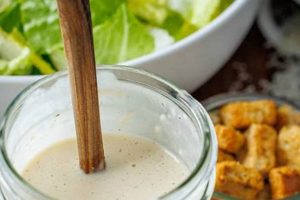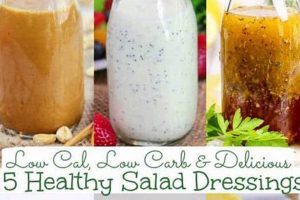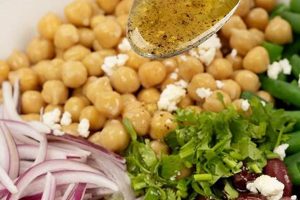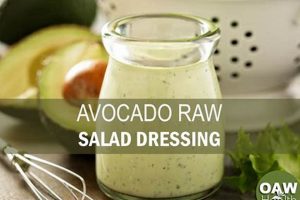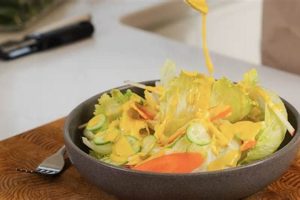Recipes for salad dressings that minimize sodium content typically utilize fresh herbs, spices, citrus juices, and vinegars for flavor instead of relying on salt. For example, a lemon-herb vinaigrette might combine fresh lemon juice, olive oil, minced garlic, chopped parsley, and a pinch of black pepper. These preparations prioritize flavor complexity while catering to dietary restrictions or health-conscious choices.
Reducing dietary sodium is often recommended for managing blood pressure and overall cardiovascular health. Historically, salt played a crucial role in food preservation, leading to higher sodium levels in many traditional recipes. Modern culinary practices, however, offer numerous ways to create flavorful dishes without excessive salt, empowering individuals to make healthier choices. Flavorful, low-sodium options allow individuals to enjoy their meals while adhering to dietary guidelines.
This exploration will delve into various techniques for crafting dressings that are both delicious and low in sodium. Specific ingredients, flavor profiles, and practical tips for recipe adaptation will be examined. Further discussion will cover the nutritional implications of sodium reduction and potential health benefits.
Tips for Low-Sodium Salad Dressing Preparation
Creating flavorful salad dressings without relying on excessive sodium requires careful ingredient selection and creative flavor combinations. The following tips provide guidance for crafting delicious, health-conscious dressings.
Tip 1: Embrace Fresh Herbs and Spices. Fresh herbs like dill, parsley, chives, and mint can add vibrant flavors to dressings. Dried spices such as oregano, paprika, and cumin offer robust flavor profiles without adding sodium.
Tip 2: Explore the Power of Citrus. Lemons, limes, and oranges provide acidity and brightness. Their zest can also contribute aromatic complexity.
Tip 3: Utilize Vinegar Wisely. Various vinegars, including apple cider, balsamic, and red wine vinegar, offer unique flavor dimensions and acidity. Experiment to find preferred combinations.
Tip 4: Enhance with Aromatics. Garlic, shallots, and ginger can be finely minced or grated to infuse dressings with pungent, savory notes.
Tip 5: Consider Flavorful Oils. Extra virgin olive oil, avocado oil, and toasted sesame oil contribute distinct flavors and textures.
Tip 6: Salt Sparingly. If using salt, add it judiciously and taste frequently to avoid over-salting. Consider using a salt substitute, but be mindful of potential flavor differences.
Tip 7: Balance Flavors. Achieving a balanced flavor profile is crucial. Adjust the proportions of acid, oil, and aromatics to create a harmonious blend.
By implementing these techniques, one can develop a repertoire of flavorful dressings that support sodium reduction goals without compromising taste satisfaction. These methods encourage culinary creativity while promoting healthier eating habits.
In conclusion, creating low-sodium salad dressings presents an opportunity to explore new flavor combinations and embrace healthier culinary practices. The information provided here serves as a foundation for creating delicious and health-conscious dressings.
1. Fresh Ingredients
Sodium reduction in salad dressings often necessitates a shift towards fresh, whole ingredients. These ingredients provide inherent flavor complexity, reducing the need for added salt. Utilizing fresh components allows for greater control over sodium content while maximizing flavor and nutritional value. This exploration delves into the critical role of fresh ingredients in crafting low-sodium salad dressings.
- Herbs:
Fresh herbs offer a wide range of flavors and aromatic profiles. Dill, parsley, chives, mint, and cilantro contribute distinct notes, enhancing dressings without sodium. For example, fresh dill adds a bright, slightly tangy flavor to a lemon-based vinaigrette, while mint complements cucumber and yogurt-based dressings. The use of fresh herbs allows for creativity and customization in low-sodium recipes.
- Citrus Fruits:
Lemons, limes, and oranges provide essential acidity to balance the richness of oils in salad dressings. Their juice and zest contribute vibrant flavors, reducing the need for salt. Lemon zest, for instance, adds a distinct aromatic complexity to vinaigrettes. Citrus fruits are integral to creating balanced and flavorful low-sodium dressings.
- Spices:
While often used in dried form, fresh spices, when available, offer intense flavor. Fresh ginger or turmeric root, for instance, can be grated into dressings for a pungent, earthy dimension. These additions contribute depth and complexity while adhering to low-sodium guidelines.
- Vegetables:
Incorporating fresh vegetables like grated carrots, finely diced bell peppers, or minced shallots adds texture and subtle sweetness to low-sodium dressings. These additions enhance both the nutritional value and the flavor profile, allowing for greater complexity without relying on salt. For instance, roasted red peppers contribute a smoky sweetness that complements balsamic vinegar.
The strategic incorporation of these fresh ingredients significantly contributes to the creation of flavorful and healthful low-sodium salad dressings. By focusing on fresh components, individuals can effectively manage sodium intake while enjoying a diverse range of delicious and nutritious salads.
2. Herb and Spice Blends
Herb and spice blends play a crucial role in low-sodium salad dressing recipes. The strategic combination of herbs and spices allows for complex flavor profiles without reliance on excess sodium. This approach compensates for reduced salt levels by introducing layered flavors derived from aromatic plants and spices. Flavorful combinations reduce the perceived need for salt, promoting healthier eating habits without sacrificing taste satisfaction. For instance, a blend of dried oregano, basil, and thyme can mimic the robust flavor of traditional Italian dressings, while a combination of cumin, coriander, and smoked paprika creates a Southwestern-inspired profile.
The versatility of herb and spice blends allows for customization based on individual preferences and dietary needs. Blends can be created in advance and stored for convenient use, simplifying the process of preparing low-sodium dressings. Pre-mixed blends offer consistency in flavor and expedite meal preparation. Furthermore, the use of dried herbs and spices offers a cost-effective and shelf-stable alternative to fresh ingredients, expanding accessibility and convenience. Experimentation with various combinations encourages culinary exploration while supporting sodium reduction goals. A blend of garlic powder, onion powder, and black pepper, for example, provides a savory base for various dressings.
Utilizing herb and spice blends in low-sodium salad dressings presents a practical and flavorful approach to healthy eating. This method offers a pathway to reducing sodium intake without compromising taste satisfaction. Careful consideration of flavor profiles and balanced blending techniques ensures palatable and nutritious results. The exploration of diverse herb and spice combinations allows individuals to discover preferred flavor profiles while adhering to dietary guidelines. This approach fosters culinary creativity while promoting long-term health benefits associated with reduced sodium consumption.
3. Citrus and Vinegar
Citrus and vinegar are fundamental components in low-sodium salad dressing recipes, providing essential acidity that balances flavors and enhances palatability. Their combined presence contributes brightness and complexity, compensating for the absence of excess salt. This exploration delves into the distinct roles of citrus and vinegar in achieving flavorful, low-sodium dressings.
- Acidity and Flavor Enhancement:
The acidity in citrus juices and vinegar brightens the overall flavor profile of salad dressings. Acidity counteracts the richness of oils, creating a balanced and refreshing taste. Specific examples include lemon juice in a Greek vinaigrette or lime juice in a cilantro-lime dressing. The sharpness provided by these acidic components enhances the perception of other flavors, making them more pronounced without relying on salt.
- Preservation and Emulsification:
Vinegar, with its inherent preservative properties, contributes to the shelf life of salad dressings. Furthermore, both citrus juice and vinegar aid in emulsification, helping to bind oil and water-based ingredients together. This creates a stable and homogenous dressing that clings to salad greens effectively. For example, the use of vinegar in a vinaigrette helps to create a smooth, evenly distributed emulsion.
- Variety and Versatility:
The diverse array of citrus fruits and vinegars allows for endless flavor combinations. From the tartness of lemon juice to the sweetness of orange juice, and from the sharpness of white wine vinegar to the mellow complexity of balsamic vinegar, each ingredient offers unique characteristics. This versatility allows for customization based on individual preferences and the specific salad ingredients. A balsamic vinaigrette, for example, complements roasted vegetables, while a lemon vinaigrette pairs well with leafy greens.
- Sodium Reduction Strategy:
Citrus and vinegar effectively replace the role of salt by providing flavor intensity. By relying on these acidic components, the need for added sodium is significantly reduced. This makes them key ingredients in health-conscious recipes, particularly for individuals monitoring sodium intake. The use of lemon juice and a small amount of black pepper, for instance, can create a flavorful dressing with minimal sodium.
The synergistic relationship between citrus and vinegar in low-sodium salad dressings contributes significantly to both flavor and functionality. Their combined use allows for the creation of dressings that are not only health-conscious but also delicious and versatile. By understanding the specific roles of these ingredients, individuals can effectively create flavorful low-sodium dressings tailored to their preferences and dietary needs.
4. Oil Choices
Oil selection significantly impacts the flavor profile, texture, and nutritional value of low-sodium salad dressings. While minimizing sodium remains a primary focus, the choice of oil contributes distinct characteristics that enhance the overall sensory experience. Understanding the properties of various oils allows for informed decisions aligned with both health goals and desired flavor outcomes. For instance, extra virgin olive oil lends a robust, peppery flavor, while avocado oil offers a neutral taste that allows other ingredients to shine. Grapeseed oil, with its high smoke point, is suitable for dressings intended for cooked or grilled salads.
The relationship between oil choice and sodium reduction extends beyond flavor. Certain oils, like flaxseed oil, offer additional health benefits, such as omega-3 fatty acids, which contribute to overall well-being. Furthermore, the viscosity of the oil influences the dressing’s texture and ability to cling to salad ingredients. A lighter oil, like sunflower oil, creates a thinner dressing, while a heavier oil, like avocado oil, results in a creamier consistency. Selecting oils with complementary flavor profiles to other dressing ingredients is crucial for a harmonious and balanced taste. For example, a toasted sesame oil complements Asian-inspired dressings, while walnut oil enhances dressings with fall flavors.
Strategic oil selection is integral to crafting successful low-sodium salad dressings. Consideration of flavor profiles, nutritional content, and textural impact allows for informed choices that support dietary goals without compromising taste. Careful balancing of oil with other components, such as citrus, vinegar, and herbs, ensures a well-rounded and palatable dressing. This understanding empowers individuals to create flavorful and healthy dressings tailored to their preferences and dietary needs.
5. Sodium Alternatives
Sodium alternatives play a significant role in low-sodium salad dressing recipes, offering a pathway to flavor enhancement without the health risks associated with excessive sodium intake. These alternatives provide salty or savory notes, mimicking the taste of traditional salt while reducing sodium content. This allows individuals to adhere to dietary restrictions or health-conscious choices without sacrificing flavor satisfaction. Potassium chloride, a common sodium alternative, provides a similar salty taste and can be incorporated into dressings to enhance flavor complexity. Other alternatives, like nutritional yeast, offer a cheesy, umami flavor that complements certain dressing profiles, such as vegan Caesar dressings. The selection of a sodium alternative depends on the desired flavor outcome and the overall composition of the dressing. For example, a lemon-herb dressing might benefit from a small amount of potassium chloride to enhance the brightness of the lemon, while a creamy avocado dressing might be complemented by the savory notes of nutritional yeast.
Effective utilization of sodium alternatives requires careful consideration of their properties and potential impact on flavor. Some alternatives possess a slightly bitter or metallic aftertaste, necessitating judicious use and balanced incorporation with other ingredients. Blending sodium alternatives with herbs, spices, and citrus can mitigate any undesirable flavors, creating a harmonious flavor profile. Additionally, gradual reduction of sodium intake, combined with the introduction of sodium alternatives, can help individuals adjust to the flavor differences and minimize the perception of any aftertaste. For instance, gradually reducing the amount of salt in a vinaigrette while incrementally increasing the amount of potassium chloride can acclimate the palate to the alternative’s flavor profile. This gradual approach allows for a smoother transition to a lower-sodium diet without a drastic change in perceived taste.
Understanding the role and application of sodium alternatives in low-sodium salad dressings is crucial for successfully managing sodium intake while maintaining flavor satisfaction. Careful selection, balanced incorporation, and gradual adaptation contribute to the creation of dressings that are both healthy and palatable. This knowledge empowers individuals to make informed choices that align with their dietary needs and flavor preferences. The integration of sodium alternatives into culinary practices contributes to a broader strategy of sodium reduction for improved health outcomes without compromising the enjoyment of food.
6. Flavor Balancing
Flavor balancing is paramount in low-sodium salad dressing recipes. Sodium reduction necessitates a nuanced approach to flavor composition, as salt often masks imbalances in other taste elements. Careful orchestration of acidity, sweetness, bitterness, umami, and fat creates a harmonious flavor profile that compensates for the absence of dominant saltiness. This intricate interplay elevates the sensory experience, demonstrating that flavor complexity can thrive without excessive sodium. A lemon-tahini dressing, for example, balances the tartness of lemon with the richness of tahini, a touch of maple syrup for sweetness, and a hint of garlic for pungency. This balanced approach allows each flavor to shine without being overpowered by salt.
The practical application of flavor balancing in low-sodium dressings involves understanding the interplay of key ingredients. Acidity, primarily from vinegar or citrus juice, provides brightness and cuts through richness. Sweetness, often derived from maple syrup, honey, or balsamic glaze, tempers acidity and adds depth. Bitterness, present in ingredients like certain greens or herbs, adds complexity and prevents the dressing from becoming overly sweet. Umami, found in ingredients like nutritional yeast or soy sauce (used sparingly), contributes savory depth. Fat, from oils like olive oil or avocado oil, provides body and carries flavor. Adjusting the proportions of these elements achieves a harmonious balance, ensuring a satisfying and flavorful dressing. For instance, in a vinaigrette, the ratio of oil to vinegar influences both the flavor and texture. Too much vinegar creates an overly sharp dressing, while too much oil results in a bland and greasy experience.
Mastery of flavor balancing in low-sodium salad dressings unlocks the potential for delicious and healthful culinary creations. This approach allows individuals to prioritize health-conscious choices without compromising taste satisfaction. The intricate interplay of flavor elements creates a symphony of taste that elevates simple salads to new heights. Furthermore, this understanding empowers individuals to experiment with various ingredients and flavor combinations, fostering culinary creativity and personalized flavor experiences. By embracing the principles of flavor balancing, one can create dressings that are not only low in sodium but also rich in flavor, proving that healthy eating can be both delicious and satisfying.
Frequently Asked Questions About Low-Sodium Salad Dressings
This section addresses common inquiries regarding low-sodium salad dressing recipes, providing practical guidance for individuals seeking to reduce dietary sodium while maintaining flavor and enjoyment.
Question 1: How can sodium levels in store-bought dressings be determined?
Checking the nutrition label on the product packaging is essential. The sodium content per serving is clearly indicated. Comparing different brands can assist in making informed choices aligned with dietary goals. Utilizing online nutritional databases or mobile applications can also provide comprehensive sodium content information for various products.
Question 2: What are effective strategies for reducing sodium in homemade dressings?
Prioritizing fresh ingredients like herbs, spices, citrus fruits, and vinegars significantly reduces reliance on added salt. Experimenting with different flavor combinations allows for the creation of flavorful dressings without excessive sodium. Using measured amounts of salt and incorporating sodium-free seasonings offers further sodium reduction strategies. Gradual reduction of salt usage can help adjust palates over time.
Question 3: Are there health risks associated with low-sodium dressings?
Individuals with specific medical conditions should consult a healthcare professional before drastically reducing sodium intake. While low-sodium diets generally benefit heart health, certain individuals might require specific sodium levels. Overconsumption of potassium-based salt substitutes can pose health risks for individuals with kidney conditions. Moderation and informed choices based on individual health circumstances are crucial.
Question 4: How can flavor be enhanced in low-sodium dressings without relying on salt?
Fresh herbs, spices, citrus zest, and infused oils offer robust flavor profiles. Balancing acidity from vinegar or citrus juice with a touch of sweetness from sources like maple syrup or honey creates complexity. Exploring umami flavors through ingredients like nutritional yeast or mushrooms can add depth without increasing sodium. Roasting vegetables before incorporating them into dressings can further enhance their flavor contributions.
Question 5: How can low-sodium dressings be stored effectively?
Storing dressings in airtight containers in the refrigerator helps maintain freshness and flavor. Proper storage prevents oxidation and microbial growth. Consuming homemade dressings within a reasonable timeframe, typically within a week, ensures optimal quality and safety. Labeling containers with preparation dates helps track freshness.
Question 6: What are versatile low-sodium dressing options suitable for various salads?
A basic vinaigrette with lemon juice, olive oil, and herbs complements most greens. A tahini-based dressing provides a creamy texture suitable for grain or bean salads. A yogurt-based dressing with herbs and spices offers a lighter option. Adapting recipes by substituting high-sodium ingredients with low-sodium alternatives ensures versatility while adhering to dietary restrictions.
Implementing these strategies allows individuals to enjoy flavorful and healthful salads while managing sodium intake effectively. Prioritizing fresh ingredients and understanding flavor balancing principles are key to successful low-sodium cooking.
The following section will provide specific low-sodium salad dressing recipes for practical application of these concepts.
Conclusion
Low sodium salad dressing recipes offer a pathway to healthful eating without compromising flavor. Exploration of fresh ingredients, herbs, spices, citrus, vinegars, and oil choices reveals the potential for diverse and satisfying flavor profiles. Strategic use of sodium alternatives and a focus on flavor balancing enable the creation of dressings that are both nutritious and palatable. Understanding ingredient interactions, proper storage techniques, and recipe adaptation empowers individuals to manage sodium intake effectively while enjoying flavorful meals.
Culinary innovation in the realm of low-sodium cuisine continues to evolve, offering promising possibilities for enhancing health outcomes through dietary choices. The ongoing development of flavorful, low-sodium options emphasizes the potential for long-term dietary changes that support well-being. Embracing these strategies facilitates a shift toward health-conscious eating patterns without sacrificing culinary satisfaction.

